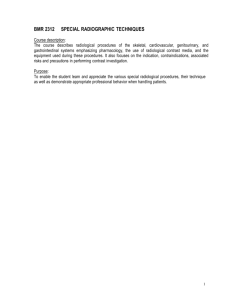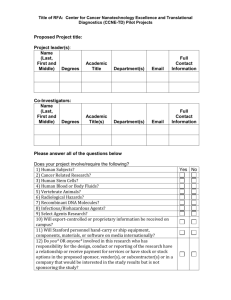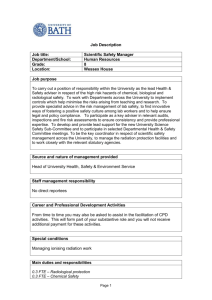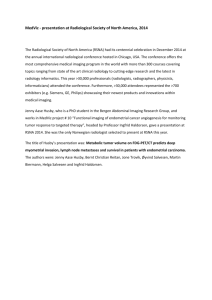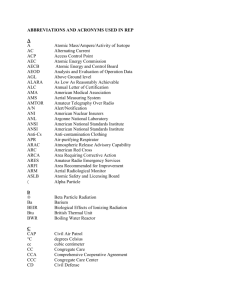Course Title: - NukeWorker.com
advertisement
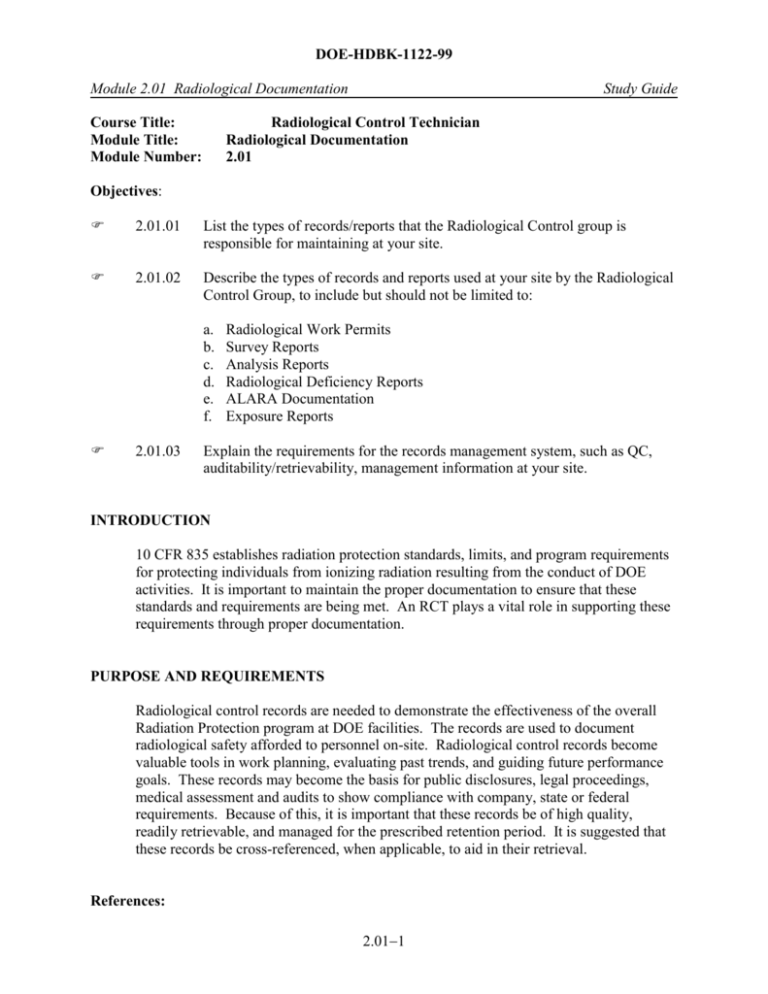
DOE-HDBK-1122-99 Module 2.01 Radiological Documentation Course Title: Module Title: Module Number: Study Guide Radiological Control Technician Radiological Documentation 2.01 Objectives: 2.01.01 List the types of records/reports that the Radiological Control group is responsible for maintaining at your site. 2.01.02 Describe the types of records and reports used at your site by the Radiological Control Group, to include but should not be limited to: a. b. c. d. e. f. 2.01.03 Radiological Work Permits Survey Reports Analysis Reports Radiological Deficiency Reports ALARA Documentation Exposure Reports Explain the requirements for the records management system, such as QC, auditability/retrievability, management information at your site. INTRODUCTION 10 CFR 835 establishes radiation protection standards, limits, and program requirements for protecting individuals from ionizing radiation resulting from the conduct of DOE activities. It is important to maintain the proper documentation to ensure that these standards and requirements are being met. An RCT plays a vital role in supporting these requirements through proper documentation. PURPOSE AND REQUIREMENTS Radiological control records are needed to demonstrate the effectiveness of the overall Radiation Protection program at DOE facilities. The records are used to document radiological safety afforded to personnel on-site. Radiological control records become valuable tools in work planning, evaluating past trends, and guiding future performance goals. These records may become the basis for public disclosures, legal proceedings, medical assessment and audits to show compliance with company, state or federal requirements. Because of this, it is important that these records be of high quality, readily retrievable, and managed for the prescribed retention period. It is suggested that these records be cross-referenced, when applicable, to aid in their retrieval. References: 1 DOE-HDBK-1122-99 Module 2.01 Radiological Documentation 1. 2. Study Guide 10 CFR Part 835 (1998) "Occupational Radiation Protection. (1999) "U.S. Department of Energy Radiological Control Standard". 2 DOE-HDBK-1122-99 Module 2.01 Radiological Documentation Study Guide RADIOLOGICAL RECORDS MANAGEMENT PROGRAM Each DOE site must have a radiological records management program to ensure that auditable records and reports are controlled through the stages of creation, distribution,use, arrangement, storage, retrieval, media conversion and disposition. The radiological records management program should include the following: a. b. c. d. e. f. g. h. i. j. k. l. m. n. o. p. q. Radiological Policy Statements Radiological Control Procedures Individual Radiological Doses Internal and External Dosimetry Policies and Procedures (including Bases Documents) Personnel Training (course records and individual records) ALARA Records Radiological Instrumentation Test, Repair and Calibration Records Radiological Surveys Area Monitoring Dosimetry Results Radiological Work Permits Radiological Performance Indicators and Assessments Radiological Safety Analysis and Evaluation Reports Quality Assurance Records Radiological Incident and Occurrence Reports (and Critique Reports, if applicable) Accountability records for sealed radioactive sources Records for release of material to Controlled Areas Reports of loss of radioactive material. 2.01.01 List the types of records/reports that the Radiological Control group is responsible for maintaining at your site. (Insert site specific information here.) RADIOLOGICAL RECORD KEEPING STANDARDS Record keeping standards have been set by the Department of Energy. In addition to the requirement of being accurate and legible, all radiological records must include the following: · · · identification of the facility, specific location, function, and process signature or other identifying code of the preparer and date legible entries in black ink 3 DOE-HDBK-1122-99 Module 2.01 Radiological Documentation · · Study Guide corrections identified by a single line-out, initialed, and dated supervisory signature to indicate review and proper completion of the forms. Each radiological control organization should maintain a file of names, signatures and initials for future identification of the person who signed or initialed a record. In addition, radiological control records should not include: · · records that are corrected using opaque substances records that contain shorthand or other nonstandardized terms. TYPES OF RADIOLOGICAL RECORDS Various types of records are included in the radiological records management program. These records fall into the following categories: Employment History Records Records detailing an employee's previous and on-going radiological work assignments, yearly doses at DOE and non-DOE facilities must be maintained. Where practical, the association between the radiation dose and job function must be preserved for trend analyses and future worker health studies. Personnel Radiological Records Occupational Radiation Dose Records must be maintained for all contractor, subcontractor, and Federal employees who are part of the personnel dosimetry program. These records include results of personnel extremity, skin, eye and whole body external dose measurements. The records also contain internal dose information, including in vivo measurements, urine, fecal and other specimen analysis and dose assessments. A complete record of radiological incidents and occurrences involving personnel dose must also be retained. The investigation and counseling of personnel radiological concerns must also be documented and maintained within the radiological control record management program. Medical Records Reports of periodic medical examinations and evaluations, respirator fit-testing results and records of medical treatment performed in support of the radiological control program should be maintained. Sites are encouraged to maintain nonoccupational radiation doses, such as therapeutic or large amounts of diagnostic radiation doses for employees. 4 DOE-HDBK-1122-99 Module 2.01 Radiological Documentation Study Guide Radiological Training and Qualification Records Records of training and qualification in radiological control are permanently maintained to demonstrate that a person received appropriate information to perform the work assignment in a safe manner. Qualification standard records are retained for on-the-job, practical and formal classroom training. Training and qualification records are available to first-line supervision and management to aid in making work assignments. Included in the training records maintained, are quizzes, tests, responses and acknowledgements of training, with the date and signature of the person trained. Instrumentation and Calibration Records Records of calibration, modification or maintenance, and periodic operational checks of fixed, portable, and laboratory radiation measuring equipment must be maintained. These records include frequencies, method, dates, personnel, training and traceability of calibration sources. Records of additional tests and checks of instrumentation used in conjunction with a suspected overexposure, questionable indication, or unusual occurrence are also be retained. Radiological Control Procedures Sites should maintain radiological control procedures, policies, ALARA records, work procedures, Radiological Problem Reports, Radiation Work Permits, and supporting data as part of their radiological control record management program. Specific requirements for each of these documents can be found in the DOE RCS. 2.01.02 Describe the types of records and reports used at your facility by the Radiological Control group, to include but should not be limited to: a. Radiological Work Permits b. Survey Reports c. Analysis Reports d. Radiological Deficiency Reports e. ALARA Documentation f. Exposure Reports (Insert site specific information here.) RECORDS MANAGEMENT All records are required to be stored in a manner that ensures that they can be retrieved, in addition to being able to maintain their integrity and security. Once a record has been created, reviewed, and signed by appropriate supervision, the record should be considered 5 DOE-HDBK-1122-99 Module 2.01 Radiological Documentation Study Guide complete and must not be modified. Subsequent errors identified in a completed record should be corrected by creating a supplemental record that includes traceability for the correction. Radiological Control records should be protected from temperature extremes, moisture, infestation, electromagnetic fields, excessive light, stacking, theft, and vandalism. Protective measures should include vaults, file rooms with fixed fire suppression, fire-rated cabinets, duplicate storage, or a combination of these. 2.01.03 Explain the requirements for the records management system, such as QC, auditability/retrievability, management information at your facility. (Insert site specific information here.) RADIOLOGICAL REPORTING All personnel that are monitored by a personnel dosimetry program shall be provided an annual report of their radiation exposure. A person may also receive a current radiation dose record upon special request. Terminating employees will be given an exposure report within 90 days of their last day of employment summarizing their radiation dose for the total period of employment at the reporting facility. 6
